Interbody vertebral prosthetic and orthopedic fusion device with self-deploying anchors
a technology of vertebral prosthesis and orthopedic fusion, which is applied in the field of spinal disorders, can solve the problems of inability to achieve features, high complexity of the spinal column, and potential irritation and erosion of the great and small vessels, and achieve the effect of ease with which the device may be used
- Summary
- Abstract
- Description
- Claims
- Application Information
AI Technical Summary
Benefits of technology
Problems solved by technology
Method used
Image
Examples
Embodiment Construction
[0036]Reference is now made to FIGS. 1A, 1B, and 1C, which illustrate an intervertebral prosthetic device 100 in accordance with one or more embodiments of the present invention. FIG. 1A illustrates a perspective view of the intervertebral device 100. FIG. 1B is a lateral (side) view with the left of the drawing being in the front (anterior) direction and the right of the drawing being in the rear (posterior) direction. FIG. 1C is an anterior elevational view of the intervertebral device 100.
[0037]The body of the device may be made from any bio-compatible material, such as any of a number of biocompatible implantable polymers, including PEKK, PEKEK, polyetheretherketone (PEEK) being preferred, titanium, ceramic, etc.
[0038]With further reference to FIG. 2, which shows the device 100 in use, the device 100 generally includes a body (or housing) that is sized and shaped to fit in the intervertebral space between adjacent vertebral bones 10, 20 of the human spine. It is understood that ...
PUM
 Login to View More
Login to View More Abstract
Description
Claims
Application Information
 Login to View More
Login to View More - R&D
- Intellectual Property
- Life Sciences
- Materials
- Tech Scout
- Unparalleled Data Quality
- Higher Quality Content
- 60% Fewer Hallucinations
Browse by: Latest US Patents, China's latest patents, Technical Efficacy Thesaurus, Application Domain, Technology Topic, Popular Technical Reports.
© 2025 PatSnap. All rights reserved.Legal|Privacy policy|Modern Slavery Act Transparency Statement|Sitemap|About US| Contact US: help@patsnap.com



